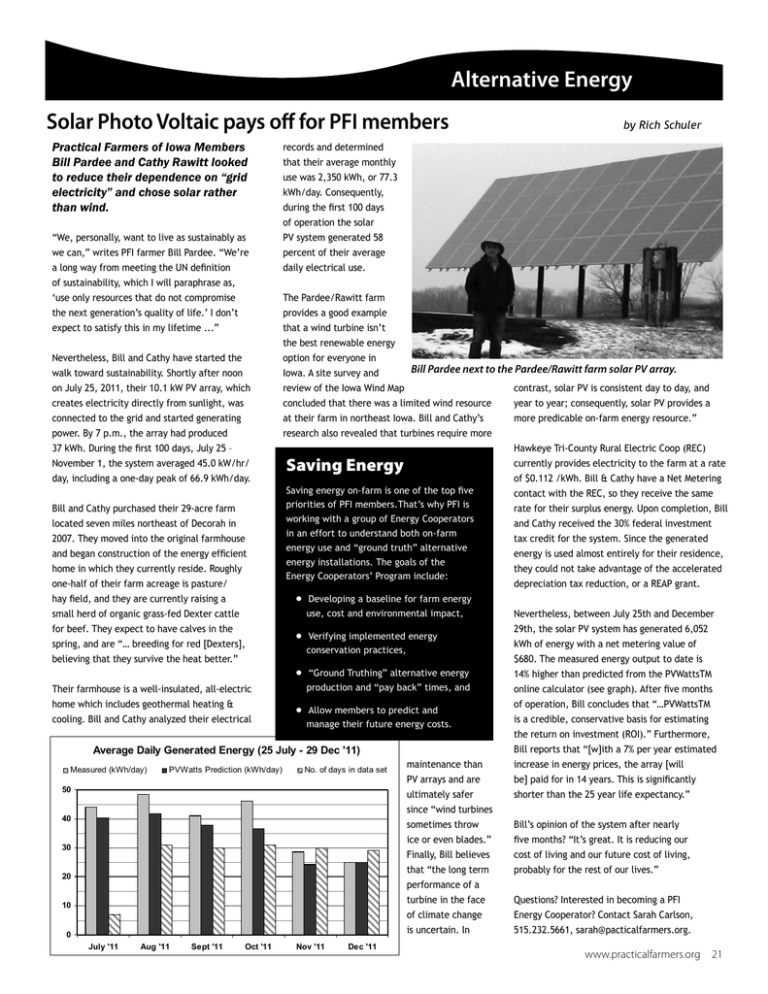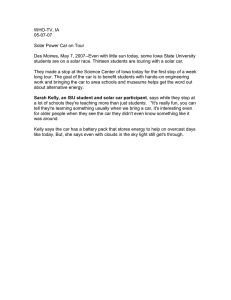Practical Farmers of Iowa Members Bill Pardee and Cathy Rawitt looked
advertisement

Alternative Energy Solar Photo Voltaic pays off for PFI members Practical Farmers of Iowa Members Bill Pardee and Cathy Rawitt looked to reduce their dependence on “grid electricity” and chose solar rather than wind. “We, personally, want to live as sustainably as we can,” writes PFI farmer Bill Pardee. “We’re a long way from meeting the UN definition of sustainability, which I will paraphrase as, ‘use only resources that do not compromise the next generation’s quality of life.’ I don’t expect to satisfy this in my lifetime ...” Nevertheless, Bill and Cathy have started the walk toward sustainability. Shortly after noon on July 25, 2011, their 10.1 kW PV array, which creates electricity directly from sunlight, was connected to the grid and started generating power. By 7 p.m., the array had produced 37 kWh. During the first 100 days, July 25 – November 1, the system averaged 45.0 kW/hr/ day, including a one-day peak of 66.9 kWh/day. Bill and Cathy purchased their 29-acre farm located seven miles northeast of Decorah in 2007. They moved into the original farmhouse and began construction of the energy efficient home in which they currently reside. Roughly one-half of their farm acreage is pasture/ hay field, and they are currently raising a small herd of organic grass-fed Dexter cattle for beef. They expect to have calves in the spring, and are “… breeding for red [Dexters], believing that they survive the heat better.” Their farmhouse is a well-insulated, all-electric home which includes geothermal heating & cooling. Bill and Cathy analyzed their electrical records and determined that their average monthly use was 2,350 kWh, or 77.3 kWh/day. Consequently, during the first 100 days of operation the solar PV system generated 58 percent of their average daily electrical use. The Pardee/Rawitt farm provides a good example that a wind turbine isn’t the best renewable energy option for everyone in Bill Pardee next to the Pardee/Rawitt farm solar PV array. Iowa. A site survey and review of the Iowa Wind Map contrast, solar PV is consistent day to day, and concluded that there was a limited wind resource year to year; consequently, solar PV provides a at their farm in northeast Iowa. Bill and Cathy’s more predicable on-farm energy resource.” research also revealed that turbines require more Hawkeye Tri-County Rural Electric Coop (REC) currently provides electricity to the farm at a rate of $0.112 /kWh. Bill & Cathy have a Net Metering Saving energy on-farm is one of the top five contact with the REC, so they receive the same priorities of PFI members.That’s why PFI is rate for their surplus energy. Upon completion, Bill working with a group of Energy Cooperators and Cathy received the 30% federal investment in an effort to understand both on-farm tax credit for the system. Since the generated energy use and “ground truth” alternative energy is used almost entirely for their residence, energy installations. The goals of the they could not take advantage of the accelerated Energy Cooperators’ Program include: depreciation tax reduction, or a REAP grant. Saving Energy • • • • Developing a baseline for farm energy use, cost and environmental impact, Verifying implemented energy conservation practices, “Ground Truthing” alternative energy production and “pay back” times, and Allow members to predict and manage their future energy costs. Average Daily Generated Energy (25 July - 29 Dec '11) Measured (kWh/day) PVWatts Prediction (kWh/day) No. of days in data set 50 40 30 20 10 0 July '11 Aug '11 Sept '11 Oct '11 by Rich Schuler Nov '11 Dec '11 maintenance than PV arrays and are ultimately safer since “wind turbines sometimes throw ice or even blades.” Finally, Bill believes that “the long term performance of a turbine in the face of climate change is uncertain. In Nevertheless, between July 25th and December 29th, the solar PV system has generated 6,052 kWh of energy with a net metering value of $680. The measured energy output to date is 14% higher than predicted from the PVWattsTM online calculator (see graph). After five months of operation, Bill concludes that “…PVWattsTM is a credible, conservative basis for estimating the return on investment (ROI).” Furthermore, Bill reports that “[w]ith a 7% per year estimated increase in energy prices, the array [will be] paid for in 14 years. This is significantly shorter than the 25 year life expectancy.” Bill’s opinion of the system after nearly five months? “It’s great. It is reducing our cost of living and our future cost of living, probably for the rest of our lives.” Questions? Interested in becoming a PFI Energy Cooperator? Contact Sarah Carlson, 515.232.5661, sarah@pacticalfarmers.org. www.practicalfarmers.org 21




